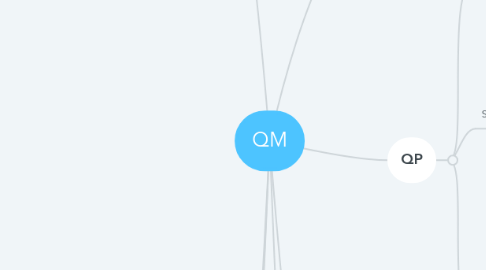
1. QC
1.1. Techniques/Method
1.1.1. Cause and Effect Diagram(Fishbone diagram)
1.1.2. Control Chart
1.1.3. Flow Chart
1.1.4. Pareto chart
1.1.5. Histogram
1.1.6. Run Chart
1.1.7. Scatter Diagram
1.1.8. Statistical Sampling
1.1.9. Inspection
1.2. Process / FrameWork
1.2.1. Rome laboratory Software framework
1.2.2. Goal Question Metric Paradigm
1.2.3. Risk Management Model
1.2.4. The Plan-Do-Check-Action Model of Quality Control
1.2.5. Total Software Quality Control
1.2.6. Spiral Model Of Software Developments
1.2.7. Control management tool
1.2.8. Quality Control Process
1.2.8.1. Incoming Quality Control
1.2.8.2. In-Process Quality Control
1.2.8.3. Outgoing Quality Assurance
1.3. Software Quality Standards
1.3.1. Editorial/Terminology
1.3.1.1. Standard Terminology Relating to Quality and Statistics
1.3.2. Reliability
1.3.2.1. Standard Practice for Factors and Procedures for Applying the MIL-STD-105 Plans in Life and Reliability Inspection
1.3.2.2. Standard Practice for Life and Reliability Testing Based on the Exponential Distribution
1.3.2.3. Standard Guide for General Reliability
1.3.3. Sampling / Statistics
1.3.3.1. Standard Practice for Probability Sampling of Materials
1.3.3.2. Standard Practice for Calculating Sample Size to Estimate, With Specified Precision, the Average for a Characteristic of a Lot or Process
1.3.3.3. Standard Practice for Acceptance of Evidence Based on the Results of Probability Sampling
1.3.3.4. Standard Practice for Dealing With Outlying Observations
1.3.3.5. Standard Terminology Relating to Design of Experiments
1.3.3.6. Standard Guide for Sampling Design
1.3.3.7. Standard Practice for Calculating and Using Basic Statistics
1.3.3.8. Standard Practice for Regression Analysis
1.3.4. Standards
1.3.4.1. IEEE/ASTM SI 10 American National Standard for Metric Practice
1.3.5. Statistical Quality Control
1.3.5.1. Standard Practice for Using Significant Digits in Test Data to Determine Conformance with Specifications
1.3.5.2. Standard Practice for Use of Process Oriented AOQL and LTPD Sampling Plans
1.3.5.3. Standard Practice for Sampling a Stream of Product by Attributes Indexed by AQL
1.3.5.4. Standard Practice for Process Capability and Performance Measurement
1.3.5.5. Standard Practice for Setting an Upper Confidence Bound For a Fraction or Number of Non-Conforming items, or a Rate of Occurrence for Non-conformities, Using Attribute Data, When There is a Zero Response in the Sample
1.3.5.6. Standard Practice for Use of Control Charts in Statistical Process Control
1.3.5.7. Standard Practice for Sampling a Stream of Product by Variables Indexed by AQL
1.3.5.8. Standard Practice for Single- and Multi-Level Continuous Sampling of a Stream of Product by Attributes Indexed by AQL
1.3.5.9. Standard Guide for Preferred Methods for Acceptance of Product
1.3.6. Test Method Evaluation and Quality Control
1.3.6.1. Standard Practice for Use of the Terms Precision and Bias in ASTM Test Methods
1.3.6.2. Standard Practice for Conducting an Interlaboratory Study to Determine the Precision of a Test Method
1.3.6.3. Standard Practice for Conducting Ruggedness Tests
1.3.6.4. Standard Guide for Evaluating Laboratory Measurement Practices and the Statistical Analysis of the Resulting Data
1.3.6.5. Standard Guide for Statistical Procedures to Use in Developing and Applying Test Methods
1.3.6.6. Standard Guide for Defining the Test Result of a Test Method
1.3.6.7. Standard Practice for Statistical Analysis of One-Sample and Two-Sample Interlaboratory Proficiency Testing Programs
1.3.6.8. Standard Practice for Estimating and Monitoring the Uncertainty of Test Results of a Test Method Using Control Chart Techniques
1.3.6.9. Standard Guide for Reporting Uncertainty of Test Results and Use of the Term Measurement Uncertainty in ASTM Test Methods
1.3.6.10. Standard Practice for Demonstrating Capability to Comply with an Acceptance Procedure
1.3.6.11. Standard Guide for Measurement Systems Analysis (MSA)
1.3.6.12. Standard Practice for Conducting Equivalence Testing in Laboratory Applications
2. QI
2.1. Techniques/Methods
2.1.1. Standard Work
2.1.2. Catchball
2.1.3. Digital Huddle Boards
2.1.4. 5S
2.1.5. Gemba Walks
2.1.6. Value Stream Mapping
2.1.7. PDSA
2.1.8. Mind Mapping
2.2. Framework/Process
2.3. Standards
2.3.1. DCCCA
3. QAn
3.1. Techniques / Methods
3.1.1. Cause-and-effect diagram
3.1.2. Check sheet
3.1.3. Control chart
3.1.4. Histogram
3.1.5. Pareto chart
3.1.6. Scatter diagram
3.1.7. Stratification
3.2. Software Quality Standards
3.3. Process / FrameWork
4. QAu
4.1. Techniques / Methods
4.2. Software Quality Standards
4.3. Process / FrameWork
5. Quality Planning
6. QA
6.1. Techniques
6.1.1. Cost-Benefit Analysis
6.1.2. Benchmarking
6.1.3. Design of Experience (DOE)
6.1.4. Control Charts
6.1.5. Histogram
6.2. Standard
6.2.1. ISO 9000
6.2.2. CMMI
6.3. Framework/Process
6.3.1. Focus on Core Business
6.3.2. Operational Cost
6.3.3. Releasing Internal Capabilities
6.3.4. Better Turn Time
6.3.5. Greater Control
6.3.6. Rising Efficiency
6.3.7. Process Optimization
6.3.8. Structured Reporting,
7. QAs
7.1. Techniques/Methods
7.1.1. Methods of deriving the effectiveness data
7.1.2. Measurement of resource data
7.1.3. Valuation of resource data
7.1.4. Measurement and valuation of health benefits (utilities)
7.1.5. Method of synthesising the costs and effects
7.1.6. Analysis of uncertainty
7.1.7. Generalisability of the results
7.2. Standards
7.2.1. IEEE
7.2.2. ISO JTC1
7.2.3. ISO SC7
8. QP
8.1. Techniques / Methods
8.1.1. Flowcharts
8.1.2. Checksheets
8.1.3. Pareto diagrams
8.1.4. Histograms
8.1.5. Control charts
8.1.6. Control limits
8.2. Software Quality Standards
8.2.1. Software Quality Assurance
8.2.2. Software Quality Plan
8.2.3. Software Quality Control
8.3. Process / FrameWork
8.3.1. Quality Control
8.3.2. Quality Improvement
8.3.3. Quality Organization and Management
8.3.4. Documented Standards and Specifications
8.3.5. Formal Qualifications of Employees
8.3.6. Formal Qualifications of Subcontractors and Suppliers
8.3.7. Documented Field Inspections
8.3.8. Control and Prevention of Nonconformances
